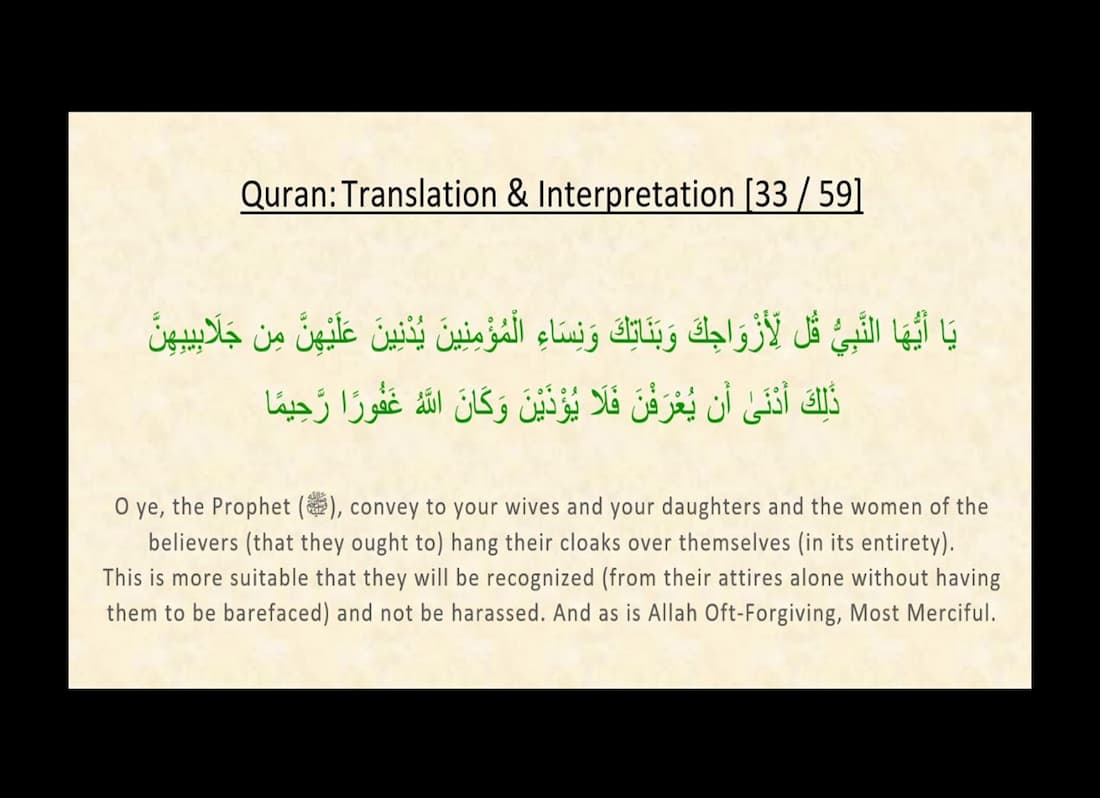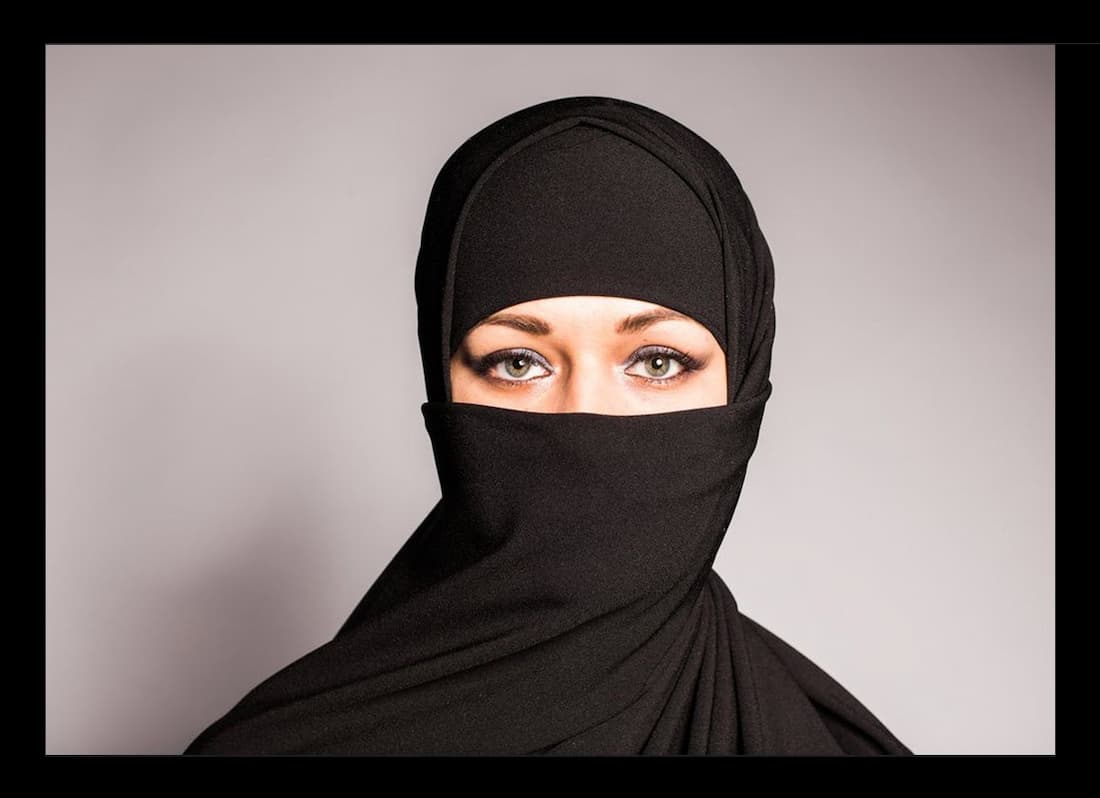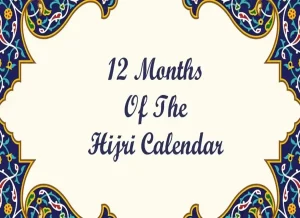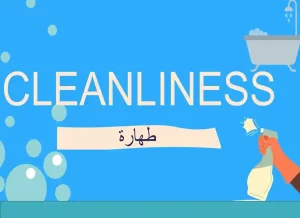WHAT IS A JILBôB?
Jilbab | Quranic verses about Hijab PDF Download- Jalóbīb is the plural of jilbób. The scholars have a difference of opinion in the meaning of jilbób. ‘Allóma Ibn Manþñr writes:
Jilbab is the outer sheet or coverlet, which is bigger than a shawl but smaller than a large sheet, used by women to hide their head and chest. It has also been said that jilbób is a big wide cloth that is smaller than a milúafa which is worn by women. Some say that milúafa is the same as Jilbab . (Lisón al-‘Arab)
He further analyzes the word milúafa and writes: It is the name given to the shawl that is used in the winter and is thrown over all the clothing [and which completely covers the clothes] like a quilt [that once a person drapes himself with it, he is protected from the cold]. Therefore, everything you use to wrap yourself with is called liúóf. Regarding the word jilbób, the respected ‘Allóma continues:
It is said that Jilbab is in fact the sheet worn by women to hide themselves from head to toe like a milúafa. It has also been said that jilbób is the sheet worn by women which, when enwrapped, covers her completely. Lisón al-‘Arab)
‘Allóma Ibn Manþñr explains that the essential meaning of jilb and jilbób is “to cover” and, more specifically, the etymological meaning of the root word Jilbab is “to hide.” He also presents two ayas in evidence of this point. One poet says: والعيش داج كنفا جلبابة
Life is like the dark night which is hidden by a sheet of difficulties. Another poet says:مجلبب من سوا د الليل جلبابا He has hidden himself with the darkness of night. The respected ‘Allóma quotes ‘Alõ g who implies the same meaning:من احبنا اهل البيت فليعد للفقر جلبابا
The person who loves us, the family of the Blessed Prophet s, should be prepared to live his life covered with a shawl of worries. ( Lisón al-‘Arab | al-Nihóya [by Ibn al-Athīr])

‘Allama Ibn Manþñr then writes:
Ibn al-‘Arabī said that the meaning of jilbób is izór. Abñ ‘Ubaid quotes Imam al-Zuhrī as saying that when Ibn al-‘Arabī interpreted jilbób as izór, he did not mean by it the sheet that is worn to cover the lower part of the body but the sheet, which when wrapped properly, will completely hide the one who wears it. Similarly, izór al-lail is the sheet which is worn when sleeping to cover oneself and which hides the body completely. ( Lisón al-‘Arab)
He further writes: Jilbab | Quranic verses about Hijab PDF Download
‘Allóma Ibn al-Athīr interprets jilbób as miqna‘ which is the cloth women wear to cover their head, back and chest. ( Ibid). In his own Lexicon, ‘Allóma ibn Manþñr defines miqna‘ as: Qina‘ or miqna‘ is the cloth which a woman wears to hide her head and her beauty. Hence, it is said:
ألقت عن وجهها قناع الحياء
She has lifted and thrown the sheet of modesty from her face. ( Ibid) The above explanation can be summarized as follows:
- The root word jilb or jilbób describes the object which completely covers something; for example, the blanket used in the winter or the darkness of night that envelops everything.
- The word jilbób specifically refers to the sheet worn by women to protect themselves from being seen by strangers. 3 The lexicon makes it abundantly clear that the sheet which is known as “jilbób” is the same sheet which is used by women to completely cover their body, especially their head, face, back, chest, etc.
After the etymological meaning, we now cite the opinions of [some of] the scholars. ‘Allóma ôlñsī writes:
According to Ibn ‘Abbós g, jilbób is the sheet which women cover themselves with from head to toe [to avoid being seen by strangers]. Ibn Jubair explains jilbób as being miqna‘. (Rñú al-Ma‘ónī 39 Al-Muúalló) . Allóma ôlñsī then quotes the opinions of different scholars on the meaning of jilbób as narrated above. ‘Allóma Ibn ûazam writes:
In the Arabic language, the language of the Blessed Prophet s, jilbób is the outer sheet which covers the entire body. A piece of cloth which is small and cannot cover the entire body cannot be called a jilbób. The second part of the aya is yudnīna ‘alaihinna (should draw down their shawls over them). ‘Allóma ôlñsī writes:
The literal meaning of ‘adnó’ is to bring something nearer, though here it means “to drop or drape something” since it is followed by [the prepositional] ‘aló, thus converting it into a transitive verb. In my opinion, the combination of these two words points to the fact that the true objective [of hijab] is for women to hide themselves in such a way that they are able to see their path as they are walking. ( Rñú al-Ma‘ónī). Imam Abñ ûayyón quotes the famous linguist Imam Kasó’ī that the meaning of yudnīna ‘alaihinna is: يقتنعن بملاحفهن منضمة عليهن
Women should cover themselves fully with the sheet and wrap the sheet around themselves completely. Commenting on the words of Imam Kasó’ī, Imam Abñ ûayyón writes:
The meaning of the word inzimóm, used by Imam Kasó’ī, is the same as adnó which means to drape the sheet and then wrap it well. In his explanation of yudnīna, ‘Allóma Zamakhsharī writes:
It means that women should cover their face with a sheet. Hence, when the veil falls from the face, the Arabs say:أدني ثوبك على وجهك.Hide your face with a veil Sa‘īd ibn Jubair explained yudnīna ‘alaihinna in the same way. After narrating the opinions of ‘Allóma Zamakhsharī and Abñ ûayyón, ‘Allóma ôlñsī writes:
In my opinion, the above discussion explains the inferred meaning; otherwise, the explicit meaning of ‘‘alaihinna’ is to cover one’s body completely with the sheet. However, in their interpretations some have only included the head and the face and ignored the entire body because it was the face that was usually left uncovered in the days of Jóhiliyya. ( Rñú al-Ma‘ónī)
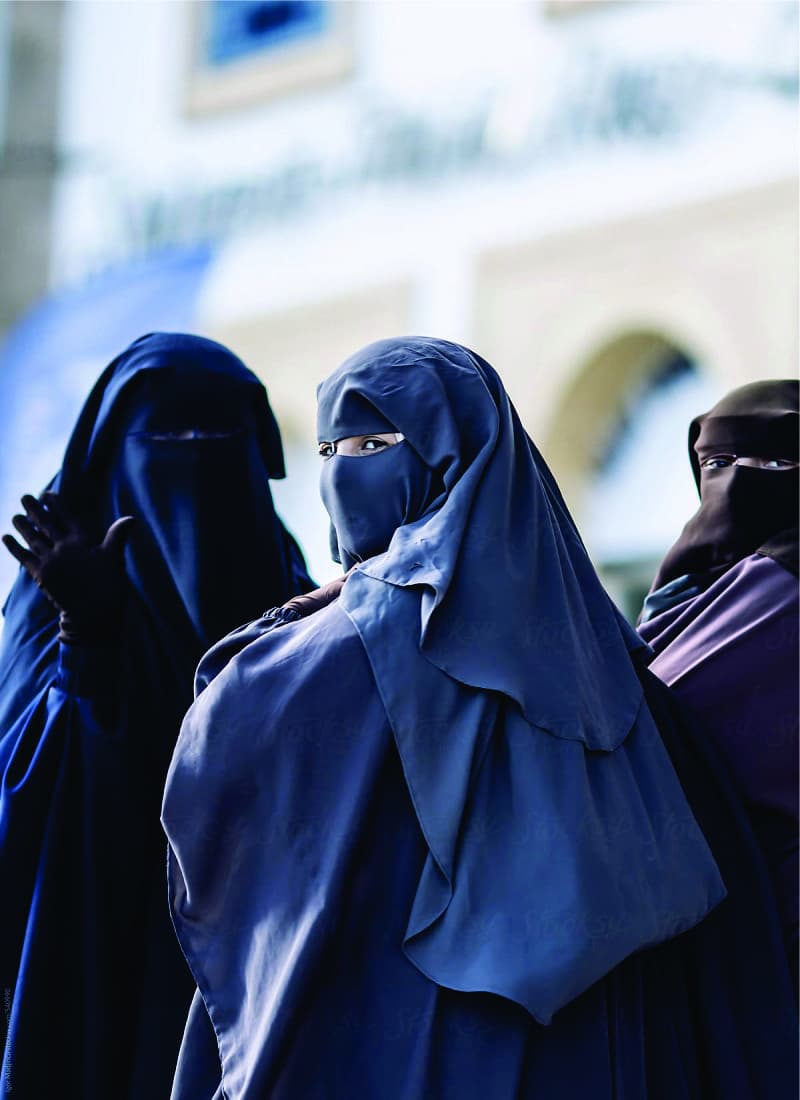
HOW SHOULD THE JILBôB BE WRAPPED?
In addition Quranic verses to laying out the ruling of hijab as being mandatory and the face being included in the meaning of hijab, the venerable scholars of Qur’an also delineated the method of how the jilbób will be worn. Qóðī Shaukónī writes:
In the interpretation of this aya, ‘Allóma Ibn Jarīr, Ibn Abī ûótim and Ibn Mardawai has narrated from Ibn ‘Abbós g that Allah has ordered Muslim women to cover their heads and hide their faces when they leave their home out of necessity and that they may only keep one eye uncovered. ( Fatú al-Qadīr)
The greatest scholar of Quranic verses , Ibn ‘Abbós , mentions two ways of wearing jilbób. According to one method, the woman can leave one eye uncovered whereas in the second method, both eyes can be left uncovered without any objections. We learned about the first method through the above reference while the second method is reported by ‘Allóma ôlñsī as follows:
‘Allóma Ibn Jarīr and Ibn al-Mundhir described the method of wearing the sheet from Ibn ‘Abbós g and Qatóda. They explain that the way to wear it is that first the woman will wrap the sheet from the top covering her forehead, then bring one side of the sheet to cover the face below the eyes including her nose. This method allows both eyes to be uncovered [which is acceptable under necessity] but it should be wrapped in such a manner that most of the face and upper body is covered. ( Rñú al-Ma‘ónī)
Imam Muúammad ibn Sīrīn, a famous tóbi‘ī [first successor after the ýaúóba ], reports the following method of wrapping the sheet. He says:
When I asked ‘Ubaida ibn Sufyón ibn ûórith al-ûaðramī the method, he actually demonstrated it with his own shawl. First, he covered his head including his forehead in such a way that it covered his eyebrows. Then with the same sheet he covered the remaining part of his face in a way that only his right eye was left uncovered. ( Rñú al-Ma‘ónī | Aúkóm al-Qur’an | Tafsīr al-Qurøubī)
After relating the above quote, ‘Allóma Ibn Jarīr writes that all the narrators [Ibn ‘Aliyya from Ibn A‘wan from Muúammad from ‘Ubaida] who narrated on the authority of ‘Ubaida demonstrated the method of wrapping the sheet to their students as [their teacher] ‘Ubaida had demonstrated to them. Along with ‘Ubaida, Imam al-Qurøubī attributes the same method to Ibn ‘Abbós g. Quoting the meaning of this aya from Ibn ‘Abbós g and Mujóhid, Imam Abñ Bakr al-Jaüüóü writes:
When leaving their home, women should not have their head and face uncovered like the slave women but should instead cover their head and forehead. ( Aúkóm al-Qur’an)
Imam Suddī relates the following method of wearing the jilbób: Women should wrap the sheet in a way that it hides the whole face including the forehead and one eye [the other eye may be left uncovered if necessary]( Rñú al-Ma‘ónī | al-Baúr al-Muúīø).
In his explanation of the aya, Imam Wóúidī writes: Women will wrap the sheet in such a manner that they will completely cover their head and face leaving only one eye uncovered. ( Fatú al-Qadīr)Allóma Ibn Sa‘d narrates from Muúammad ibn Ka‘b al-Quraþī: Women should wrap the sheet so that it covers the face completely leaving only one eye uncovered. ( Ibid)
After narrating this point, Imam Abñ ûayyón writes: It is our custom in Andalusia that when women leave the house, they leave only one eye exposed while the remaining face is completely covered. Besides the aforementioned scholars, all the mufassirñn from the time of the Blessed Prophet s to the present day, explain this aya in the same manner. They agree that women are required to cover themselves when coming out of their homes and that hiding of the face is included in the hijab. To quote every one of these scholars would make this book drawn-out; however, it is worthwhile to quote a few renowned scholars. Imam Ibn Jarīr writes:
In this aya, Allah u is ordering the Blessed Prophet s to ask his wives, his daughters, and all Muslim women not to dress like slave women leaving their heads and faces uncovered when coming out of their homes [out of necessity]. Instead, they should cover themselves with a cloak that covers their faces in order that no one stands in their way and everyone knows that they are upright citizens. ( Tafsīr Ibn Jarīr)
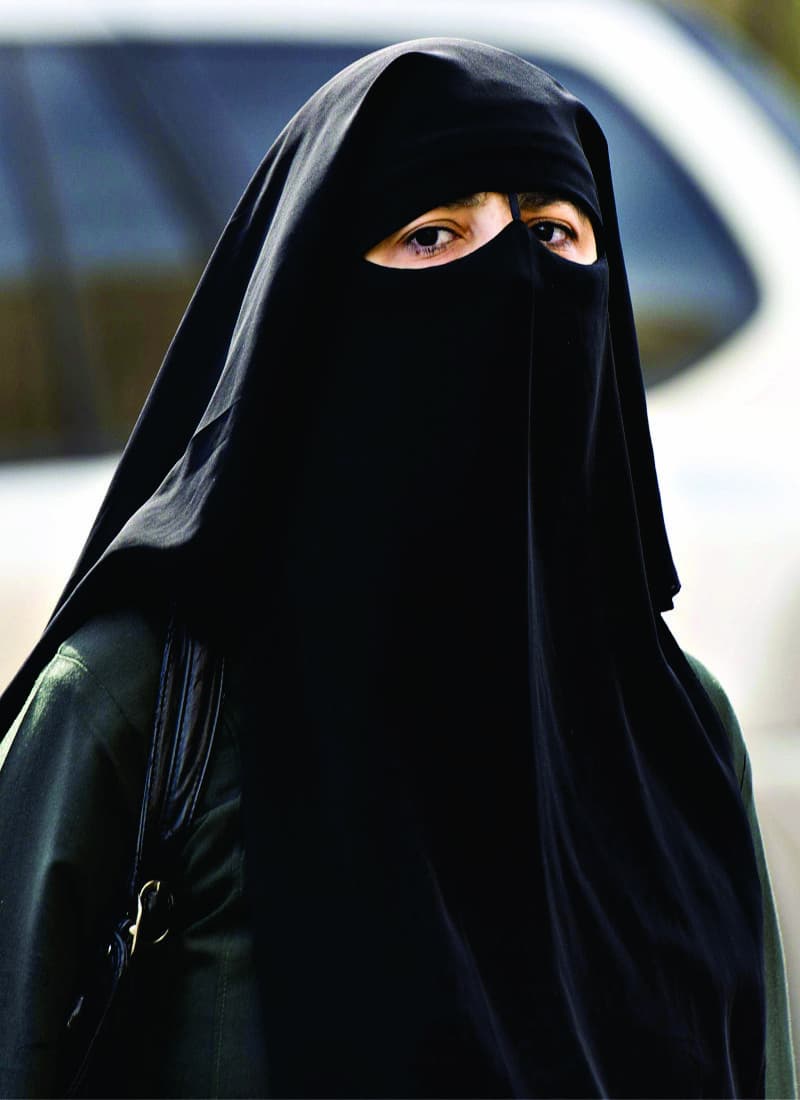
Imam Abñ Bakr al-Jaüüóü writes:
This aya is evidence that young women must cover their faces in front of strangers and that they should cover and be modest so that ill-natured people do not entertain bad thoughts about them. ( Aúkóm al-Qur’an)
Imam ‘Imód al-Dīn al-Kiyóharós writes:
Jilbab is used to describe a big sheet. In this aya, Allah u orders Muslim women to cover their head and faces [when leaving their homes]. ( Ibid)
‘Allóma al-Naishóbñrī writes:
In the early days of Islam, all women came out dressed in knee-length shirts and scarves as was the custom in the days of Jóhiliyya. There was no difference in the dresses of street women and the women from respectable families. Then Allah u commanded [Muslim women] to cover their heads and faces with sheets so that people would differentiate them from street women. ( Gharó’ib al-Qur’an Verses)
Imam al-Rózī writes:
Women from respectable families and slave women came out of their homes without any hesitation and the immoral people would follow them in the days of Jóhiliyya. In this aya, Allah u ordered the honorable women to cover themselves with a sheet so that they could be recognized [as respectable women]. There are two ways to be recognized. Firstly, by their dress which exhibits their modesty. Secondly, no one will expect a woman who covers her face, though it is not part of her satr (Portion of the body required by the Shari‘a to be covered and which cannot be exposed in front of others.) and therefore is not obligatory to hide, to agree to uncover any other part of her satr. Additionally, this dress will affirm her being a modest and veiled woman who cannot be corrupt. ( Tafsīr al-Kabīr)
Qóðī al-Baiðóiwī writes:
When Muslim women leave their home out of necessity, they should hide their faces and bodies with a sheet. Here the word min (from) is used for tab‘īð (partiality) which means to use one part of the sheet to cover the face and the other to wrap around the body. ( Tafsīr al-Baiðówī)
Imam Ibn Kathīr writes:
In this aya, Allah u is ordering the Blessed Prophet s to inform the Muslim women in general, and his wives and daughters more specifically, due to their high status, to use sheets to cover their faces when leaving their home. This will distinguish them from the women of the days of Jóhiliyya. ( Tafsīr Ibn al-Kathīr)
Imam al-Suyñøī writes:
This aya is proof that all Muslim women must cover; hence, it is mandatory to hide the face and head as part of the covering. ( Aun al-Ma‘bñd, fī Qaul Illóh Yudnīna ‘alaihinna min)
The author of Jómi‘ al-Bayón writes:
Jilbab is the sheet which is used on top of the scarf and completely covers the woman from head to toe; hence, it is mandatory for Muslim women to wear a sheet to veil themselves and cover the entire body and face with it. ( Ibid)
Imam Abñ ûayyón states:
The advantage in observing hijab is that such women are recognized as pious and respectable. Thus, perverts will not trail after them and such women will not have to suffer improprieties. Nobody will dare follow and make advances towards a woman who has completely concealed herself. On the contrary, if one comes out adorned and without hijab, the malicious and evil-minded people will have high hopes of such women. ( al-Baúr al-Muúīø)
Imam al-Qurøubī writes:
During the days of Jóhiliyya (Jilbab ) , women behaved vulgarly and they came out with their faces uncovered, attracting men’s attentions and they became the object of their mental debauchery. Thus, in the Qur’an, Allah u ordered the Blessed Prophet s to instruct the Muslim women to veil their faces when they leave their homes [out of necessity]. ( Tafsīr al-Qurøubī)
‘Allóma Ibn al-Jauzī writes:
According to Imam Ibn Qutaiba, the meaning of this aya is that Muslim women must cover themselves with big sheets. According to other scholars, the aya means that sheets should be worn to cover the face and head so that anyone who saw them would know that they are respectable free women [not slave women]. ( Zód al-Masīr)
Imam Abñ al-Sa‘ñd states:
The meaning of the aya is that when women leave their home out of necessity, they should cover their face and body with a sheet. ( Tafsīr Abñ Sa‘ñd)
Imam al-Nasafī writes:
Imam Mubarrad said that the meaning of yudnīna ‘alaihinna is that women should veil themselves and cover their faces and bodies with a sheet because when the veil is removed from the face of a woman, the Arabs say: أدني ثوبك على وجهك Hide your face with your sheet The word min in the aya is for tab‘īð meaning that part of the sheet should be worn to hide the body while the other part to cover the face so that they can be differentiated from the slave women. The conclusion is that in this aya Muslim women have been ordered to cover their face and head so that lustful people do not become hopeful. ( Madórik al-Tanzīl)
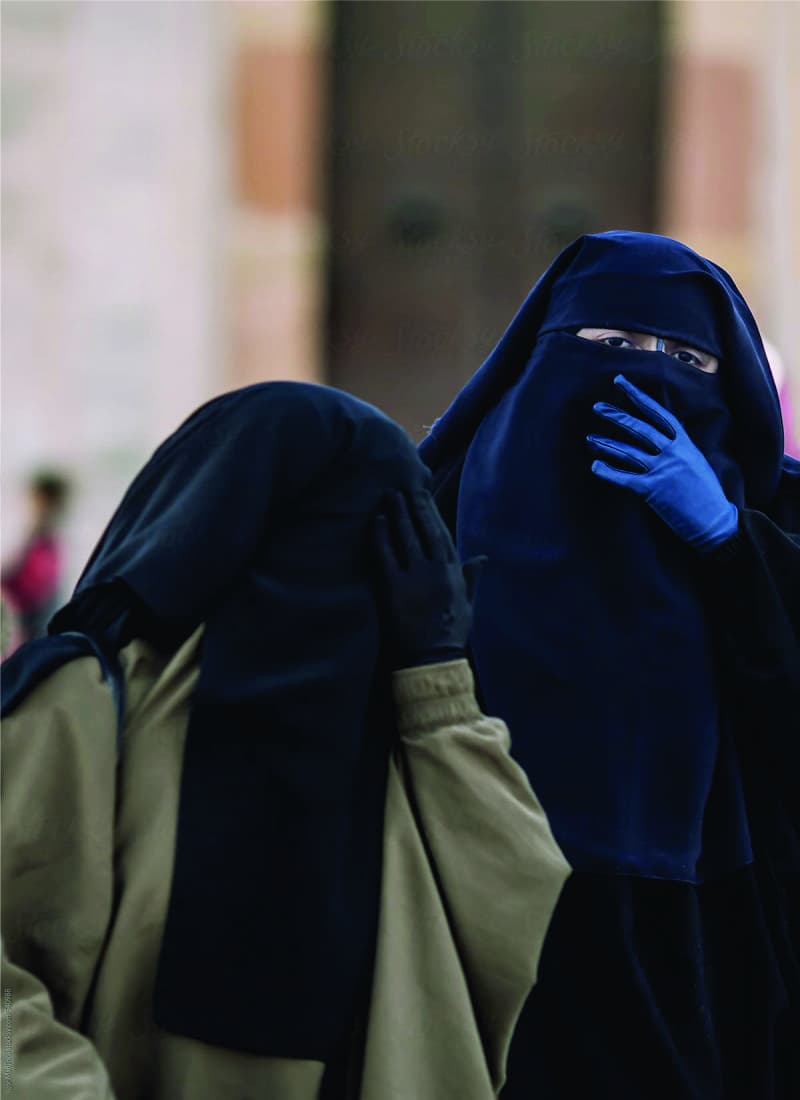
‘Allóma al-Jaml writes:
The aya means that women should cover their faces and bodies so that they can be differentiated from slave women and singers. ( Tafsīr ôyót al-Aúkóm) These quotations are taken from some of the renowned mufassirñn. Otherwise, almost all the mufassirñn explain this aya to include hiding of the face in the meaning of hijab. It is also noteworthy that among these scholars are followers of every one of the four schools of fiqh (Islamic jurisprudence). Thus, all the ûanafī, Shafi‘ī, Hanbalī and Mólikī schools agree that veiling the face is a part of the hijab.
And [remember that] this is not a theoretical discussion. The aúódõth clearly state that all women, including the wives of the Blessed Prophet s, implemented this ruling immediately after the revelation of this aya and the use of jilbób and hijab by women quickly became the norm of Muslim society. Actually, it was exemplary how readily the Muslim women obeyed and practiced it. Imam ‘Abd al-Razzóq narrated from Umm Salama :عن أم سلمة قالت لما نزلت هذه الآية يدنين عليهن من جلابيهن خرج نساء الأنصار كأن على رؤوسهن الغربان من الاكسية
After revelation of the aya, yudnīna ‘alaihinna min jalóbībihinna, the ladies of Anüór came out of their homes with cloaks [so it appeared] as if crows were on their heads [i.e. the black cloaks draped them completely]. ( Rñú al-Ma‘ónī)
Further details will be presented regarding this subject in the following chapters. It should be noted here that the modern day ‘abóya [which Muslim women wear in certain countries] also serves as a jilbób. It is this hijab, which was established amongst the women from the onset of Islam, that is now being questioned by westernized Muslims. To accomplish this, they interpret the Qur’an and aúódõth according to their own desires, thereby going astray and leading others on the same path. May Allah u guide all of us and protect us from the fitan.
